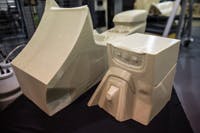Automakers have been using 3D printing for years to help generate prototypes. However, use of the technology in automotive applications (particularly for making production parts) has traditionally been limited by the size of the printers, print speeds, and quality.
Ford is taking a step closer to making larger prototypes and production vehicles with the deployment of the Stratasys Infinite Build 3D printer at its Ford Research and Innovation Center in Dearborn. The company is piloting the new printer, and initially looking at building larger prototype parts, tooling, and possibly custom production parts for low-volume vehicles.
“With Infinite Build technology, we can print large tools, fixtures and components, making us more nimble in design iterations,” said Ellen Lee, Ford technical leader, additive manufacturing research. “We’re excited to have early access to Stratasys’ new technology to help steer development of large-scale printing for automotive applications and requirements.”
“We built the system with two industries in mind, automotive and aerospace,” says Jim Vurpillat, director of automotive and aerospace at Stratasys. “It opens up large format prototyping applications, tooling, and because of it’s speed you can even get into production parts.”
In automotive production, 3D printing can be used to create complex shapes, which can help turn multi-part assemblies into a single piece. Parts like spoilers could also be printed with lighter weight materials.
Prototype tooling can also be produced in just a few days at much lower cost than using traditional manufacturing methods. This can make it easier to adjust new vehicle designs and product multiple prototype components.
Ford has been working with Stratasys on 3D printing projects for 20 years. The Infinite Build system as installed last fall.
The Infinite Build printer is able to print structures with nearly unlimited height. Traditional printers create items vertically – material is laid down in layers, gradually building upwards. The new Stratasys solution uses fused deposition modeling (FDM), but the print area is horizontal rather than vertical. Depending on the set up, the height of the print area can be extended significantly.
The system also uses micropellets rather than filament, which is the case with other types of 3D printers. The head of the extruder can move and rotate in three dimensions, which helps create more complex shapes.
“The micropellets are heated and then extruded through the head, which has increased print speeds dramatically,” Vurpillat says. “It operates ten times faster than our current large-format machine, the Fortus 900MC.”
The system is also set up for continuous operation. Because build times are still long, a robotic material handling system can feed material into the system. Currently, the Infinite Build printer uses Ultem 9085, an aerospace-grade thermal plastic. Eventually, there will be other materials available for the printer.
When design collective Local Motors printed an entire car (the Strati) in a live demonstration a few years ago, the company used the Big Area Additive Manufacturing (BAAM) system from Cincinnati Inc., which utilized a traditional layering approach. The system has an extruder on a robotic arm attached to a gantry system.
During the demonstration, the Local Motors team had to reduce the size of the parts being printed to maintain integrity because of deformation problems encountered during early tests – otherwise, they had planned to print the body of the car in one piece. The car took roughly 40 hours to print.
Ford will be able to prototype large parts like center consoles, instrument panel substrates, large rocker panels, and other components using Infinite Build. They also plan to print tooling.
For production parts, Vurpillat says that early applications would likely be custom or unique parts. Production parts also have to pass through more stringent quality control processes, which could be a challenge.
3D printing also shows promise for aftermarket or performance parts/accessories production. “When you have volume requirement sin automotive, you don’t have the ability to do much customization,” Vurpillat says. “3D printing gives you that capability whether you are talking about service parts, aftermarket parts, or accessories.”
For example, Stratasys has worked with Japanese company Daihatsu Motor Co. to create customizable effect skins that can be placed on the rear and front bumpers of their cars.
Boeing has also deployed one of the printers in a pilot program to help create low-volume, lightweight parts. “One of their interests is in tooling,” Vurpillat says. “Tooling for carbon fiber parts tends to be large and expensive, so they want to explore how Infinite Build could be used for those applications. It gives them a wider scope to utilize 3D printing for tooling or fixturing for larger parts.”
Stratasys will work closely with both Boeing and Ford to identify new materials and applications for the printing system. “We think there is a lot of potential, and we’ve had a lot of interest from other automakers and aerospace companies,” Vurpillat says. “We’re working with them to find out where the real benefits are, and they are helping us to perfect the system, which will have benefits for the entire industry.”




